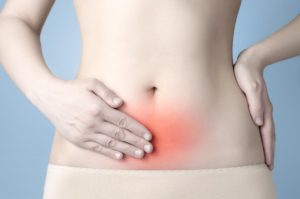 Endometriosis (en-doe-me-tree-O-sis) is an often painful disorder in which tissue that normally lines the inside of your uterus — the endometrium — grows outside your uterus. Endometriosis most commonly involves your ovaries, fallopian tubes, and the tissue lining your pelvis. Endometriosis is a painful and chronic disorder. This abnormality can cause significant pain, particularly during a menstrual period. The disorder usually starts withing a few years of the onset of menstruation and ends with menopause. Endometriosis affects over 5 million women in North America.
Endometriosis (en-doe-me-tree-O-sis) is an often painful disorder in which tissue that normally lines the inside of your uterus — the endometrium — grows outside your uterus. Endometriosis most commonly involves your ovaries, fallopian tubes, and the tissue lining your pelvis. Endometriosis is a painful and chronic disorder. This abnormality can cause significant pain, particularly during a menstrual period. The disorder usually starts withing a few years of the onset of menstruation and ends with menopause. Endometriosis affects over 5 million women in North America.
Symptoms
One of the most common symptoms of endometriosis is painful menstruation. Endometriosis causes pelvic pain and cramping that can begin days before a menstrual period and continue for days after. One dangerous symptom of endometriosis is excessive bleeding during menstruation. Other symptoms include painful intercourse, bowel movements and urination, fatigue, bloating, and nausea. One devastating symptom of endometriosis is infertility. It is estimated that over 30% of women suffering from endometriosis will be unable to get pregnant.
Causes
The cause of endometriosis is unknown. One theory is that the endometrial tissue is deposited in unusual locations by the retrograde flow of menstrual debris through the Fallopian tubes into the pelvic and abdominal cavities. The cause of this retrograde menstruation is not clearly understood. While experts have yet to pinpoint an exact cause, several generally agree upon explanations in additions to retrograde menstruation, embryonic cell growth, surgical scar implantation, endometrial cells transport, and immune system disorder.
Are You at Risk
There are several factors that increase the risk of endometriosis. A genetic theory that is being studied worldwide by doctors bases strong evidence on the idea that endometriosis is hereditary. Early studies show that women with a family history of endometriosis are more likely to have daughters who suffer from the disease. Endometriosis is a common disorder that affects women during their reproductive years. If you have a history of pelvic infections o, uterine abnormalities or have never had a child, endometriosis is more likely to occur.
Treatment Options
Most often, women suffering from endometriosis are treated with drugs or surgery, although doctors typically recommend conservative treatment before surgery. The Endometriosis Foundation of America recommends several alternative and natural methods for treating this disorder:
- Diet & Nutrition
- Acupuncture
- Exercise
- Aromatherapy
- Osteopathy
- Chiropractic Treatment
Several studies show that chiropractic adjustments and care can effectively manage dysmenorrhea and women report pain relief while under care . There is a strong relationship between the location of the spinal cord and the location of the reproductive organs. As such, chiropractic care helps to minimize distortions in areas of the body where the reproductive organs are located.
Contact Us (859-727-6888) for more information!
—
About All Star Chiropractic
Unlike conventional medicine, which focuses on attempting to treat disease once it occurs, All Star Chiropractic and Rehabilitation emphasizes improving your health in an effort to reduce the risk of pain and illness in the first place. Most people would rather be healthy and avoid illness, if they could. This is one of the main reasons for the big surge in the popularity of our wellness center.
>> Learn More


